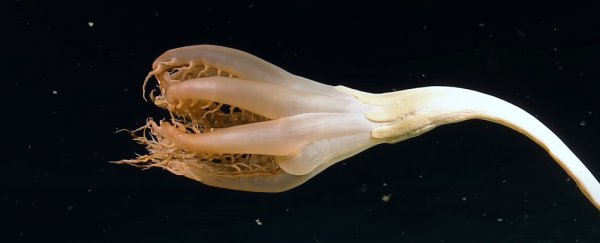New footage showing a giant, peculiar-looking tentacled sea creature floating languidly in the depths of the Pacific Ocean has left researchers questioning if what they're seeing is a new species.
A team of scientists spotted the strange animal while on board the E/V Nautilus, a research vessel used by the Ocean Exploration Trust – a nonprofit organization conducting deep-sea research.
In arecently released video, the expedition researchers oohed and aahed as images of the bizarre creature came into focus.
"My mind is blown right now," one of the scientists on board can be heard saying off-camera, as the boat's remotely operated vehicle (ROV) scanned the ocean floor and inched closer to the strange sight. "I'm not on the edge of my seat or nothing," another scientist quipped.
Moments later, the scientists spied another of the oddball creatures nearby, though they were unable to record video of the second individual.
With tentacles extending 16 inches (40 centimeters) from a nearly 7-foot-long (2 meters) stalk, and a single feeding polyp with barbed tentacles cupping the polyp like spiky petals, the creature resembled a very strange, free-swimming flower that was roughly the size of the ROV.
It was spotted July 7 at 9,823 feet (2,994 m) below the surface near a previously unexplored seamount north of Johnston Atoll, an unincorporated US territory and a National Wildlife Refuge in the Pacific Ocean west of Hawaii.
Researchers initially suspected that they had crossed paths with Solumbellula monocephalus, also known as a Solumbellula sea pen, which is part of the Cnidaria phylum that includes jellyfish, hydras and coral.
However, the only known sightings of sea pens prior to this have occurred in the Atlantic and Indian oceans, so it's possible that the scientists may have stumbled upon a new species.
Related:10 weird creatures found in the deep sea in 2021
Steve Auscavitch, the expedition's lead researcher and a deep-sea biologist and post-doctoral scholar at Boston University, described the sighting as "fascinating".
"From time to time, we come across something that we never expected to see, and those are often the most powerful observations," he told Live Science.
He added: "We were nearing the end of our cruise and were at the bottom of the seafloor when we observed the two [sea pens]. The one we captured on video was massive, possibly the same size or larger than Hercules, our ROV. When I saw this amazing sea pen on video, I knew exactly what it could be."
But just to be sure, Auscavitch sought input from biologists on shore, who helped confirm his suspicions that it was a sea pen, a coral relative.
Based on the animal's impressive size, Auscavitch surmised that it was rather old, however he can't give a specific age. (Sea pens reach maturity at five or six years of age, and can live for more than a decade.)
"Prior to this, Solumbellula monocephalus had never been seen in the central Pacific and never collected," he said.
Interestingly, his team's discovery came several months after scientists in Spain named two new genera of sea pens: Pseudumbellula and Solumbellula, the latter of which would include the new species. Those findings were published in February in the journal Invertebrate Systematics.
However, Auscavitch said that more research needs to be done to determine if this is the first Pacific Solumbellula monocephalus or potentially a new species in the ocean basin.
"Findings like this are rare, and we never expected to see something like this," he said. "The most exciting part of this research is that we come across these things from time to time, and it really does expand our horizon about where animals can live and exist in the deep sea."
Related content:
Deep-sea squid mom carries dazzling pearl-like string of eggs
This article was originally published by Live Science. Read the original article here.
